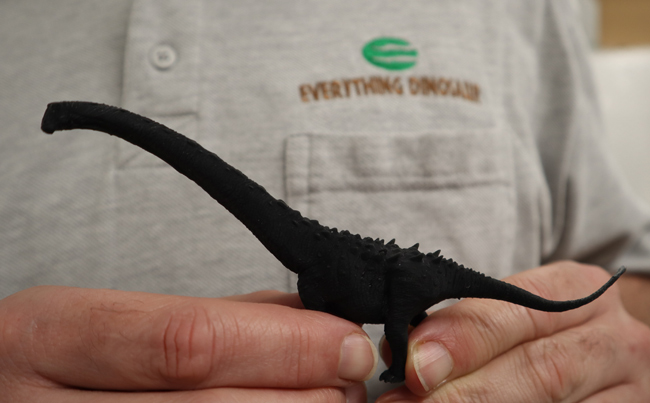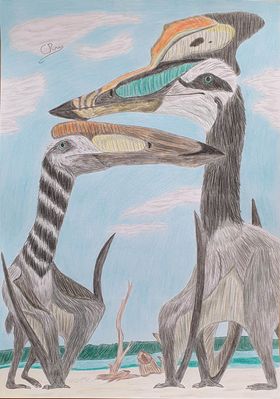Hateg Basin Sauropods – A Helpful Explanation
A scientific paper was published earlier this week that announced two new Hateg Basin sauropod taxa. These dinosaurs were named Petrustitan hungaricus and Uriash kadici. At least four sauropod taxa are known from the Hateg Basin. However, as the sediments in this region cover several million years, it is likely that these four taxa were not contemporaneous. It is also likely that additional sauropod genera are represented in the fossil deposits.
To read Everything Dinosaur’s earlier blog post about this new study: New Hateg Basin Sauropods are Described.
We have been asked to provide a little more information on the largest of these four sauropod taxa. As this area consisted of a series of large islands at the end of the Cretaceous, it was thought that the dinosaur fauna in this region consisted mostly of dwarf forms. However, this idea of the Hateg Basin dinosaur fauna representing examples of “island dwarfism” has been challenged. For example, the newly described U. kadici is thought to amongst the biggest European Late Cretaceous sauropods know to science.
The Hateg Basin Sauropod Fauna – A Complex Picture
The first sauropod to be named and described from this region of western Romania was Magyarosaurus. The German palaeontologist Friedrich von Huene erected this genus in 1932. He assigned three species to this genus.
- Magyarosaurus dacus – now recognised as the only valid species.
- The nomen dubium Magyarosaurus transsylvanicus – a nomen dubium with assigned fossil material thought to represent more than one species of sauropod.
- Magyarosaurus hungaricus – renamed in 2025 as Petrustitan hungaricus (Verónica Díez Díaz et al).
It is likely that the substantial number of fossils, often isolated and fragmentary remains found in western Romania represent several more, as yet undescribed sauropod taxa.

The Wild Past Magyarosaurus dinosaur model, a replica of this dwarf titanosaur taxon. Picture credit: Everything Dinosaur.
Picture credit: Everything Dinosaur
The picture shows a model of the dwarf titanosaur Magyarosaurus sent to Everything Dinosaur by Wild Past.
To view the range of Wild Past models and figures in stock: Wild Past Prehistoric Animal Figures.
Uriash kadici – A Giant Amongst Hateg Basin Sauropods
The second, newly described Hateg Basin sauropod is an outlier in terms of size. Whilst three of the four Hateg Basin sauropod taxa described to date were relatively small, Uriash kadici was much larger. Size estimates vary but it could have had a body length of around twelve metres.
Mike from Everything Dinosaur explained that three of the four known Hateg Basin sauropod taxa were relatively small. Although size estimates vary, it is possible to compare these four taxa and to produce a scale drawing.
- Magyarosaurus dacus – 3 metres (<1 tonne).
- Paludititan nalatzensis – 6 metres (2 tonnes).
- Petrustitan hungaricus – 6-7 metres (2 tonnes+).
- Uriash kadici – 12 metres (5-8 tonnes).

Comparing the size of Hateg Island sauropods. Uriash kadici is the biggest taxon described to date. Picture credit: Everything Dinosaur from Brian Cooley/Dan Horatiu Popa/Hateg County UNESCO Global Geopark.
Picture credit: Everything Dinosaur from Brian Cooley/Dan Horatiu Popa/Hateg County UNESCO Global Geopark
Uriash kadici is the largest titanosaurian taxon described to date from the Hateg Basin. It is larger than most of the other Late Cretaceous European titanosaurs. Its size is only surpassed by Abditosaurus (A. kuehnei). Abditosaurus fossils come from southern Pyrenees of Spain. It was formally described in 2022 (Vila et al). Abditosaurus is thought to have measured around seventeen metres long.
To read a blog post about this dinosaur: Abditosaurus – The First New Dinosaur of 2022.
What’s in a Name?
The genus name comes from the Romanian word ‘uriaș’ (pronounced ‘uriash’). It refers to gigantic humanoid characters from Romanian folklore. The species name honours Ottokár Kadić (1876–1957), a geologist and palaeontologist of the Royal Geological Survey of Hungary and discoverer of several continental vertebrate-bearing fossil localities in the north-western Hateg Basin, including the type locality of Uriash.
Mike from Everything Dinosaur explained that the recent study focusing on the Hateg Basin sauropods had expanded knowledge about European titanosaurs. However, much remains to be discovered. New fossil quarries will be opened, and new material will help to fill in the gaps and provide palaeontologists with a better understanding of Late Cretaceous sauropod evolution.
Visit the award-winning Everything Dinosaur website: Dinosaur Toys and Models.




















